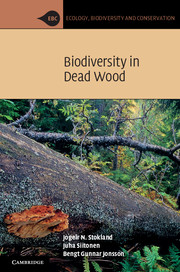Book contents
- Frontmatter
- Contents
- Preface
- 1 Introduction
- 2 Wood decomposition
- 3 The saproxylic food web
- 4 Other associations with dead woody material
- 5 Host-tree associations
- 6 Mortality factors and decay succession
- 7 Microhabitats
- 8 Tree size
- 9 The surrounding environment
- 10 Evolution of saproxylic organisms
- 11 Species diversity of saproxylic organisms
- 12 Natural forest dynamics
- 13 Dead wood and sustainable forest management
- 14 Population dynamics and evolutionary strategies
- 15 Threatened saproxylic species
- 16 Dead wood in agricultural and urban habitats
- 17 The value and future of saproxylic diversity
- References
- Index
16 - Dead wood in agricultural and urban habitats
Published online by Cambridge University Press: 05 June 2012
- Frontmatter
- Contents
- Preface
- 1 Introduction
- 2 Wood decomposition
- 3 The saproxylic food web
- 4 Other associations with dead woody material
- 5 Host-tree associations
- 6 Mortality factors and decay succession
- 7 Microhabitats
- 8 Tree size
- 9 The surrounding environment
- 10 Evolution of saproxylic organisms
- 11 Species diversity of saproxylic organisms
- 12 Natural forest dynamics
- 13 Dead wood and sustainable forest management
- 14 Population dynamics and evolutionary strategies
- 15 Threatened saproxylic species
- 16 Dead wood in agricultural and urban habitats
- 17 The value and future of saproxylic diversity
- References
- Index
Summary
Dead wood and saproxylic species do not occur only in forests. A rich saproxylic community also inhabits dead wood in habitats created by people, both in agricultural and urban landscapes, such as pasture woodlands and parks. Human-maintained habitats can provide important sites, or even the last footholds, for surprisingly many rare saproxylic species. Until recently, the biodiversity value and management of trees in agricultural and urban settings have not received the attention they deserve, despite the fact that these environments often contain greater concentrations of ancient and valuable trees than managed forests. In fact, most readers of this book are likely to find not only the closest populations of saproxylic species, but also the closest populations of threatened saproxylic species, only a few kilometres away, in the nearest park where old, hollow trees occur.
In this chapter, we deal with the occurrence, conservation and management of saproxylic species in different kinds of cultural environments, excluding forests managed primarily for wood production, which were treated in Chapter 13.
- Type
- Chapter
- Information
- Biodiversity in Dead Wood , pp. 380 - 401Publisher: Cambridge University PressPrint publication year: 2012
- 6
- Cited by

